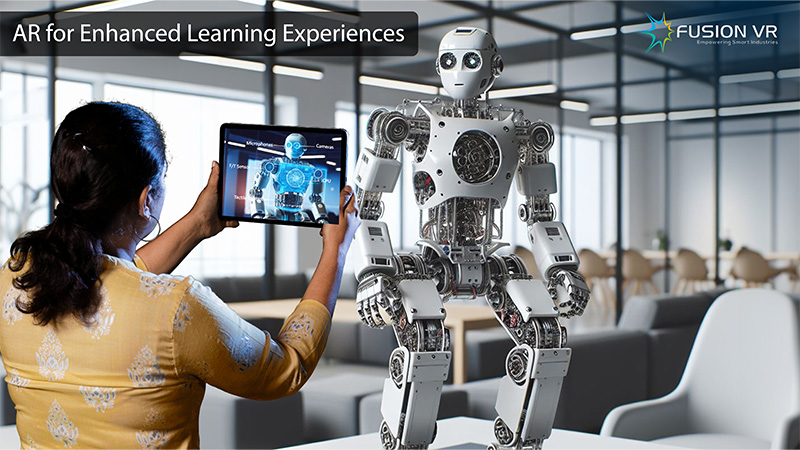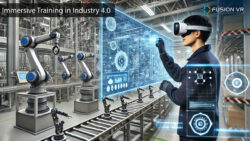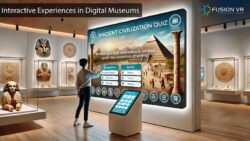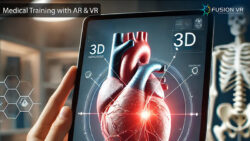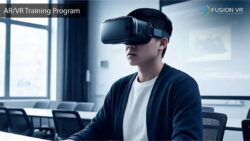In this rapidly changing world of education and technology, Augmented Reality (AR) has emerged as one of the innovational tools to change how knowledge will be imparted and skills developed. Adoption of AR courses in different educational spheres has been going beyond hype to just a trend, rather a paradigm shift in enhancing engagement, understanding, or application. AR is transcending the divide that has existed between theoretical concepts and real-world applications to bring a more applicable feel to learning. This blog elaborates on how AR courses have redesigned education and skill development, adding value to the learning space of students and professionals.
The main advantage of AR is in overlaying, adding digital content to the real world so that learners can interact not only with 3D models but also with simulations and even interactive environments. This dynamic process lends itself better to the understanding of subjects that are usually quite hard to learn in a straightforward approach. Whether in medicine or engineering, architecture, or the arts, AR is all about giving that much applied experience so important to mastering complex concepts and techniques. The multisensory use of senses by AR courses makes the whole experience not just memorable, but also fun.
Indeed, for example, AR in science education proves itself invaluable. Students could see molecular formations, the living organism’s anatomy, or observe how complicated machinery functions without setting foot inside a laboratory. Such visualization converts attention from physical resources to learning activity. With AR, one is enabled to play around various scenarios and make observations on drawing conclusions-the crux of scientific inquiry.
Likewise, AR technology is transforming medical education for budding medics. With augmented simulated reality, students can perform surgical procedure demonstrations, explore the human body in three dimensions, and understand complex medical conditions. Such realistic simulations will create an interactive environment for the learners to practice in developing skills without risk while boosting confidence and readiness for practice in the real world. AR courses are the key to reducing errors and improving the quality of medical education, ultimately helping patients and the health care system.
AR applications has opened new doors to the world of engineering and technical training. Indeed, now, would-be engineers can actually assemble and disassemble machinery, test the structural designs, and even make dynamic systems work without the financial hassle of expensive prototypes. This creates experience in solving problems and critical thinking skills needed to excel in technical fields. AR courses also provide practical exposure into tools and techniques in industries that learners would have come across in their own workspaces, which make them bridge the gap between academic learning and real-life application in today’s world.
In addition to the technical fields, AR has also been a boon in the creative arts and design. For example, whether interior designing or fashion designing, AR basically lets the user experiment with possible colors, patterns, and layouts in a virtual environment. So, for example, for a fashion student, it helps her see how a drape will appear with a model; or, for a person interested in interior decorating, he or she can make changes to how furniture appears in a whole virtualized room. Such previewing, instantaneous tweaking, and speedy manipulations provide a great source for creativity as well as accuracy, giving or enabling learners to perfect their craft before putting them into action in the real world.
The scope of AR course learning is beyond formal education; corporate training and ongoing professional development also entered the AR space. Many companies tap the potential of AR to develop training programs that allow interactions with modules or activities simulating real scenarios for employees. Such an approach is an effective means of improving skill acquisition and retention, rendering more competent and efficient workforces. For example, safety training programs based on AR enable employees to navigate through dangerous environments while practicing emergency procedures without exposure to actual hazards.
In addition to that, the classes intended for augmentation are very special since they are inclusive. They do accommodate varying learning styles, so any visual or auditory or kinesthetic learner may as well reap the educational benefit. Besides, using augmentation, education becomes a thing one can easily open up for disabled persons because it provides individual learning experiences that could be unique to their learning needs. Such kind of understanding from AR applications would involve converting text into a visual representation or simulating in a touchable manner, thereby making a more inclusive and empowering environment.
This is one of the best promises of AR in education, which can improve students’ cooperation and teamwork. When adding AR technology to collaborative projects or group learning activities, it allows students to work together to solve problems, develop solutions, and share ideas. It enhances students’ learning and prepares them for the actual landscape of work-life, where teamwork has become essential. It provides a platform where children from different geographical areas can integrate with one another in a shared virtual space, further breaking up the walls of national borders.
Moreover, AR courses consider the principles of the modern educational system through tests, textbooks or by other ways. It transforms lesson content into a fun sequence of games keeping students entertained. Apart from adding fun factors, gamification adds competition, individual time learning and target creation. All these features will be great for AR courses targeted toward students as they would have found boring what used to be teaching methods in classes.
Augmented reality has yet another plus point, scalability concerning AR courses. It requires little infrastructure compared to other learning institutions and can be practiced in several venues. Today, with the advent of AR-enabled devices like smartphones, tablets, and smart glasses, students can attend AR courses from virtually anywhere. Hence, it ensures no confinement of education and skill development into classrooms or training centers but is available for every person linked with the internet.
AR in education and skill development will grow even wider due to technological advancements in the coming future. Interfacing artificial intelligence (AI) to AR will afford further personalization of the learning experience. The data will be analysed by AI to infer the progress of the learner, diagnosing areas where there should be improvement, and resizing AR content afterward. That’s how AR plus AI can change education, increasing efficiency, engagement, and learner centricity.
Despite the advantages of adopting courses on AR, there are still certain restraints. The cost of creating AR-rich content and procuring AR-ready devices would pose a barrier to the majority of educational institutions and organizations less equipped to develop AR. Moreover, it would also require skilled professionals to design and implement an AR-based curriculum effectively. These challenges could be solved with a concerted effort from educators, cost-effective policy making, and an understanding of technology providers.
Finally, it’s changing how education and learning occur through augmented reality courses, more interactive, engaging, and hands-on approaches to learning. They cater to various disciplines, including science, medicine, arts, and corporate training, as these could help students fail or succeed in their areas. AR courses prepare individuals for modern requirements with engagement and inclusiveness. As technology advances, this AR potential is going to be extensive with future technologies that opens up pathways in education that are harder and harder to imagine: when “learning” goes beyond acquiring knowledge, bringing that knowledge within mastery is what defines an individual ultimately.

